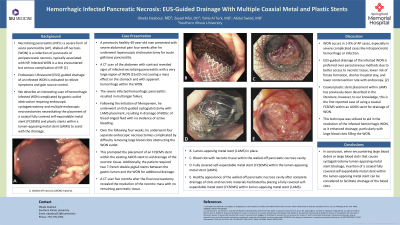Monday Poster Session
Category: Interventional Endoscopy
P2850 - Hemorrhagic Infected Pancreatic Necrosis: EUS-Guided Drainage With Multiple Coaxial Metal and Plastic Stents
Monday, October 28, 2024
10:30 AM - 4:00 PM ET
Location: Exhibit Hall E

Has Audio

Obada Daaboul, MD
Southern Illinois University
Springfield, IL
Presenting Author(s)
Obada Daaboul, MD1, Zeyad J. Rifai, DO1, Yahia Al Turk, MD1, Abdul Swied, MD2
1Southern Illinois University, Springfield, IL; 2Southern Illinois University School of Medicine, Springfield, IL
Introduction: Necrotizing pancreatitis (NP) is a severe form of acute pancreatitis (AP). Walled-off pancreatic necrosis (WOPN) is a collection of pancreatic or peripancreatic necrosis, typically associated with NP. Infected WOPN is a less encountered but serious complication of NP. Endoscopic Ultrasound (EUS)-guided drainage of an infected WOPN is indicated to relieve symptoms and gain source control. We describe an interesting case of hemorrhagic infected WOPN complicated by gastric outlet obstruction requiring endoscopic cystogastrostomy and multiple endoscopic necrosectomies necessitating the placement of a coaxial fully covered self-expandable metal stent (FCSEMS) and plastic stents within a lumen-apposing metal stent (LAMS) to assist drainage.
Case Description/Methods: A healthy 40-year-old man presented with severe abdominal pain four weeks after he underwent laparoscopic cholecystectomy for acute gallstone pancreatitis. An abdomen CT revealed findings suggestive of a 15x20 cm hemorrhagic infected WPON. The severe infected hemorrhagic pancreatitis resulted in multiorgan failure. Following the initiation of Meropenem, he underwent an EUS-guided cystogastrostomy with LAMS placement, resulting in drainage of 600cc of blood-tinged fluid with no evidence of active bleeding. Subsequently, he underwent four separate endoscopic necrosectomies complicated by difficulty removing large blood clots obstructing the WOPN outlet, prompting the placement of an FCSEMS stent within the existing AXIOS stent to aid drainage of the necrotic tissue. Also, the patient required two 7-french double pigtail stents between the gastric lumen and the WOPN for additional drainage. A CT scan five months after the final necrosectomy revealed the necrotic mass resolved with no remaining pancreatic tissue.
Discussion: WOPN occurs in 1-9% of AP cases, especially in severe complicated cases like intrapancreatic hemorrhage or infection. EUS-guided drainage of the infected WOPN is preferred over percutaneous methods due to better access to necrotic tissue, lower risk of fistula formation, shorter hospital stay, and lower reintervention rate with endoscopy. Coaxial plastic stent placement within LAMS has previously been described in the literature, however, to our knowledge, this is the first reported case of using a coaxial FCSEMS within an AXIOS stent for drainage of WOPN. This technique was utilized to aid in the resolution of the infected hemorrhagic WOPN, as it enhanced drainage, particularly with large blood clots filling the WOPN.

Disclosures:
Obada Daaboul, MD1, Zeyad J. Rifai, DO1, Yahia Al Turk, MD1, Abdul Swied, MD2. P2850 - Hemorrhagic Infected Pancreatic Necrosis: EUS-Guided Drainage With Multiple Coaxial Metal and Plastic Stents, ACG 2024 Annual Scientific Meeting Abstracts. Philadelphia, PA: American College of Gastroenterology.
1Southern Illinois University, Springfield, IL; 2Southern Illinois University School of Medicine, Springfield, IL
Introduction: Necrotizing pancreatitis (NP) is a severe form of acute pancreatitis (AP). Walled-off pancreatic necrosis (WOPN) is a collection of pancreatic or peripancreatic necrosis, typically associated with NP. Infected WOPN is a less encountered but serious complication of NP. Endoscopic Ultrasound (EUS)-guided drainage of an infected WOPN is indicated to relieve symptoms and gain source control. We describe an interesting case of hemorrhagic infected WOPN complicated by gastric outlet obstruction requiring endoscopic cystogastrostomy and multiple endoscopic necrosectomies necessitating the placement of a coaxial fully covered self-expandable metal stent (FCSEMS) and plastic stents within a lumen-apposing metal stent (LAMS) to assist drainage.
Case Description/Methods: A healthy 40-year-old man presented with severe abdominal pain four weeks after he underwent laparoscopic cholecystectomy for acute gallstone pancreatitis. An abdomen CT revealed findings suggestive of a 15x20 cm hemorrhagic infected WPON. The severe infected hemorrhagic pancreatitis resulted in multiorgan failure. Following the initiation of Meropenem, he underwent an EUS-guided cystogastrostomy with LAMS placement, resulting in drainage of 600cc of blood-tinged fluid with no evidence of active bleeding. Subsequently, he underwent four separate endoscopic necrosectomies complicated by difficulty removing large blood clots obstructing the WOPN outlet, prompting the placement of an FCSEMS stent within the existing AXIOS stent to aid drainage of the necrotic tissue. Also, the patient required two 7-french double pigtail stents between the gastric lumen and the WOPN for additional drainage. A CT scan five months after the final necrosectomy revealed the necrotic mass resolved with no remaining pancreatic tissue.
Discussion: WOPN occurs in 1-9% of AP cases, especially in severe complicated cases like intrapancreatic hemorrhage or infection. EUS-guided drainage of the infected WOPN is preferred over percutaneous methods due to better access to necrotic tissue, lower risk of fistula formation, shorter hospital stay, and lower reintervention rate with endoscopy. Coaxial plastic stent placement within LAMS has previously been described in the literature, however, to our knowledge, this is the first reported case of using a coaxial FCSEMS within an AXIOS stent for drainage of WOPN. This technique was utilized to aid in the resolution of the infected hemorrhagic WOPN, as it enhanced drainage, particularly with large blood clots filling the WOPN.

Figure: A. Walled-off pancreatic necrosis (WOPN) material.
B. Lumen-apposing metal stent (LAMS) in place.
C. Blood clot with necrotic tissue within the walled-off pancreatic necrosis cavity.
D. Fully covered self-expandable metal stent (FCSEMS) within the lumen-apposing metal stent (LAMS).
E. Healthy appearance of the walled-off pancreatic necrosis cavity after complete drainage of clots and necrotic materials facilitated by placing a fully covered self-expandable metal stent (FCSEMS) within lumen-apposing metal stent (LAMS).
B. Lumen-apposing metal stent (LAMS) in place.
C. Blood clot with necrotic tissue within the walled-off pancreatic necrosis cavity.
D. Fully covered self-expandable metal stent (FCSEMS) within the lumen-apposing metal stent (LAMS).
E. Healthy appearance of the walled-off pancreatic necrosis cavity after complete drainage of clots and necrotic materials facilitated by placing a fully covered self-expandable metal stent (FCSEMS) within lumen-apposing metal stent (LAMS).
Disclosures:
Obada Daaboul indicated no relevant financial relationships.
Zeyad Rifai indicated no relevant financial relationships.
Yahia Al Turk indicated no relevant financial relationships.
Abdul Swied indicated no relevant financial relationships.
Obada Daaboul, MD1, Zeyad J. Rifai, DO1, Yahia Al Turk, MD1, Abdul Swied, MD2. P2850 - Hemorrhagic Infected Pancreatic Necrosis: EUS-Guided Drainage With Multiple Coaxial Metal and Plastic Stents, ACG 2024 Annual Scientific Meeting Abstracts. Philadelphia, PA: American College of Gastroenterology.
